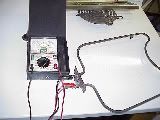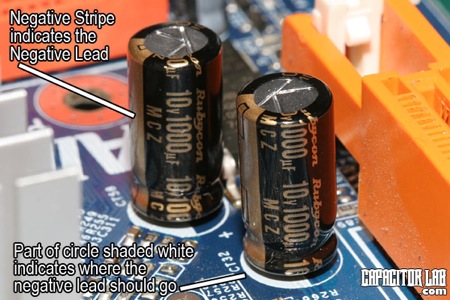This range had two complaints. One was that the gas grill module wouldn’t ignite.
The other complaint was that the cooling fan would come on at 100F and stay on– very annoying, also very common in this model. In addition, the temperature on the display would never increment beyond 100F even though the actual oven temperature could be 350F. Both of these problems point to a bad Power Relay Board (PRB).

Corroded Spark Electrode
This corroded spark electrode is one of the reasons the customer called me– no spark at her grill module. The cause is obvious but you still make sure that you’re at least getting spark to the electrode. In this case, the spark was being delivered but getting grounded out by the broken hood. The hood was so corroded that it actually separated from the rest of the assembly. It’s positioned this way in this photo just for your viewing pleasure.

Jenn-Air Range Rear View and Cubby – 1
Notice this range has both gas and 50 amp, dedicated 240vac power supply– that’s ‘cuz it’s a combi-range: electric oven and gas stove. Ranges that are gas-only just need a conventional 120vac wall outlet (for the oven lamp, spark module and/or ignitor).

Jenn-Air Range Rear View and Cubby – 2
Usually, on these Jenn-Air jobs, you need to shut off and disconnect the gas supply. Got lucky in this case– they had used a generous length of flex tubing for the "last mile" connection to the range. SoooWEEET! All’s I had to do was unplug the electrical, remove the vent duct from the downdraft fan (remove the kickpanel from the front bottom, you’ll see it right there) and pull ‘er back. Good to go beaver!

Back Panel View
The PRB is located in the back of the range behind this rear panel. Back panel is held on with 4 1/4" screws. Comes right off and exposes… (that’s your cue to go to the next pic)…

Back of Range with Rear Panel Removed
… a big ‘ol hairy mess o’ wires! And the component of interest: the Power Relay Board.

Power Relay Board
Bunch of connections on this board! Best way to change it out is to do one wire at a time. Helps if you have another pair of arms. In my case, that other pair was attached to my son, Stephen, who was a big help on this job. Also helped with the electrode changeout– more on that in just a bit.

Side View
Now, according to the service manual, in order to remove and replace the spark electrode for the surface modules, you need to tear down the entire top assembly of the range. A royal pain in the gluteous because it involved about a gazillion screws and it’s fraught with danger because any of the screws could be rusted and stripped, especially in a range that age. All of this can slow you way down. But, thankfully I had an extra pair of hands with me on the job and I put ’em to good use.

Underside of Top Pan Showing How the Electrode Attaches
That’s the nut that has to come off, unstring the spark wire, re-string the new electrode and then secure it with that nut. Yeah, it’s as narrow as it looks.

New Spark Electrode Installed
There it is all shiny and purdy!
Parts Used in this Repair Job:
Power Relay Board (PRB)
Spark Electrode
To learn more about your range/stove/oven, or to order parts, click here.













